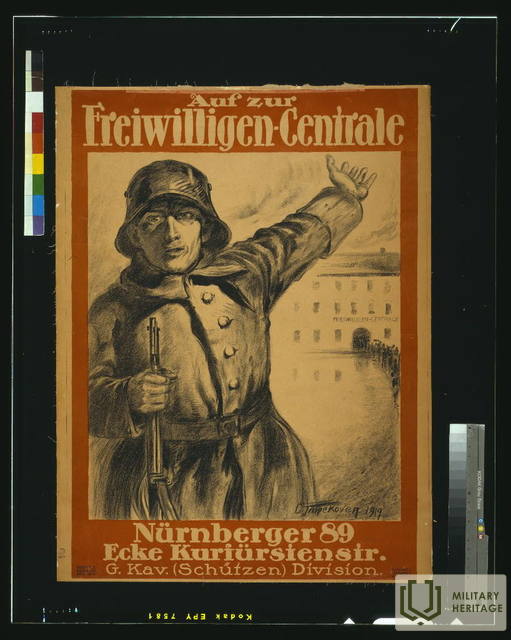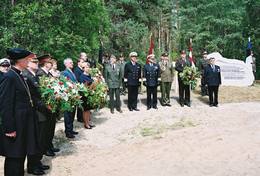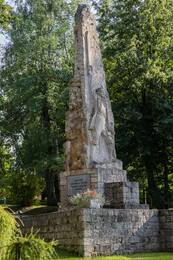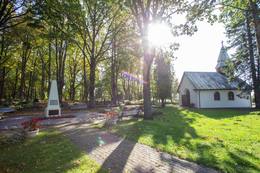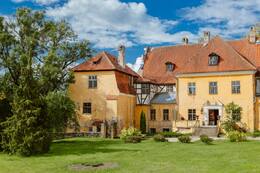Vokiečių geležinė brigada
I WW1, I Nepriklausomybės karai
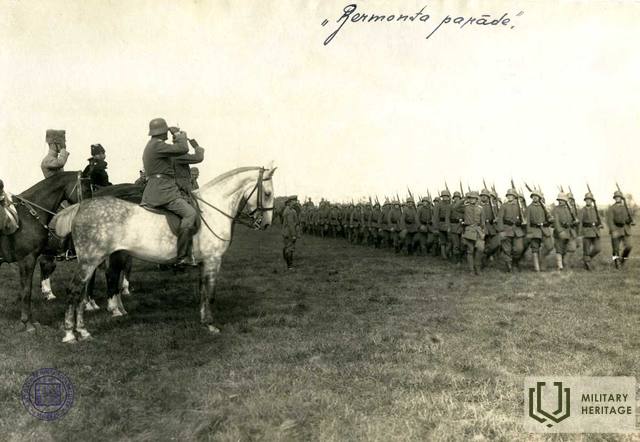
1918 m. lapkričio 29 d. Veimaro Respublikos įgaliotasis atstovas Augustas Vinnigas ir Vokietijos kareivių centrinė taryba privertė Vokietijos 8-osios armijos vadovybę duoti leidimą suformuoti savanorių brigadą gynybai nuo Raudonosios armijos 7-osios armijos ir Vakarų armijos, kurios lapkričio 25 d. pradėjo puolimą prieš žlungančius Vokietijos armijos dalinius, kurie atsitraukė be didesnio pasipriešinimo. Iki gruodžio 9 d. į brigadą savanoriškai įstojo 1500 vokiečių kareivių iš maždaug 100 000–150 000 8-osios armijos kareivių.
Gruodžio 29 d. Latvijos laikinoji vyriausybė sudarė su Augustu Vinnigu sutartį dėl pilietybės suteikimo savanoriams, kovojantiems prieš bolševikus, dėl savanorių iš Vokietijos priėmimo į Latvijos Landesverą, įsipareigodama suteikti Latvijos pilietybę vokiečių savanoriams bent 4 kovos su bolševikais savaitėms. Matyt, remdamasis šia sutartimi, Rüdigeris fon der Golzas buvo gavęs Vokietijos karo ministro Noskės leidimą verbuoti savanorius samdinius iš Vokietijoje esančiųjų, taip pat iš demobilizuojamų 8-osios armijos karių.
Nors daugelį demobilizuotų Vokietijos armijos kareivių viliojo pelno ir žemės galimybės Latvijoje, daugelis labiau domėjosi galimybe tęsti karą ir karinius nuotykius. Tuo metu Vokietijoje ir jos okupuotose rytinėse teritorijose buvo suformuoti daugybė laisvųjų korpusų dalinių, kurie atsisuko prieš socialdemokratų vadovaujamą Vokietijos Respubliką. Sparčiai plūsti savanoriai prasidėjo vasarį. Jei tikėti fon der Golzu, 1919 m. vasarą įvairių vokiečių ir Baltijos vokiečių dalinių skaičius siekė 30–40 000 kareivių.[3] Iki 1919 m. balandžio Kurše buvo surinkta apie 6000 vokiečių savanorių.
Geležinė brigada vykdė savo užduotis, pridengdama kariuomenės atsitraukimą iš Vidžemės į Kuršą. 1919 m. sausio 17 d., kai dalinį Vainodėje perėmė naujasis vadas Bišofsas, jis turėjo 284 durtuvus ir 22 kardus. Personalas buvo nuolat pildomas ir išaugo nuo kelių šimtų vyrų 1918 m. lapkritį ir gruodį iki 4000 vyrų (iš kurių 1714 buvo kovinėje rikiuotėje), 10 patrankų, 89 kulkosvaidžių ir vieno lėktuvo 1919 m. vasario pabaigoje. VIII armijai pasitraukus iš Baltijos šalių, ji buvo pavaldi VI rezervinio korpuso (Golcs) vadovybei. Kovo pradžioje ji dalyvavo Latvijos žemės sargybos puolime prieš LSPR armiją Skrundos-Saldus kryptimi (Geležinės brigados kairysis sparnas, šalia kurio buvo Landesvero Kalpak batalionas) Mažeikių-Laižuvos kryptimi (dešinysis sparnas).
Kovo 10 d. Goldfeldo eskadrilė paliko diviziją ir perėjo į Latvijos laikinosios vyriausybės tarnybą. 22.05. Geležinės divizijos daliniai vykdė kovinius veiksmus prieš bolševikus palei Jelgavos–Rygos plentą, o vėliau užėmė Geležinį tiltą per Dauguvą Rygoje. Užėmus Rygą, Geležinė brigada buvo dislokuota Bolderājoje ir Daugavgryvos tvirtovėje. Pervadinta į „Geležinę diviziją“. 1919 m. birželio viduryje ją sudarė 3 pėstininkų pulkai, 1-ajame ir 2-ajame pulkuose – po 3 batalionus, o 3-iajame pulke – tik 2 batalionai, iš viso 8 batalionai. Be jų, diviziją taip pat sudarė nedidelis jėgerių batalionas ir 3 lengvosios artilerijos divizijos, po 3 baterijas kiekvienoje divizijoje. Kiekvienoje baterijoje buvo 4 pabūklai. Batalionus sudarė 3 šauliai ir 1 kulkosvaidžių kuopa. Kiekvienas pulkas taip pat turėjo nedidelę minosvaidžių kuopą iš 4 minosvaidžių. Diviziją taip pat sudarė vienas kavalerijos pulkas iš 4 eskadrilių, 2 pionierių kuopos ir 437-oji aviatorių eskadrilė. Po pralaimėjimo Cėsių mūšyje 1919 m. birželio 26 d. Geležinė divizija perėjo Latvijos laikinosios vyriausybės (A. Niedro kabineto) žinion – divizijos personalas neprarado Vokietijos pilietybės, o atsargos ir atlyginimai liko Vokietijos kariuomenės žinioje.
Daugiau informacijos šaltinių
https://vesture.eu/Dzelzsdiv%C4%ABzija
https://lv.wikipedia.org/wiki/Dzelzsdiv%C4%ABzija#Dzelzsbrig%C4%81de
Susijusi laiko juosta
Susijusios vietos
Atminimo akmuo Latvijos ir Estijos kariams, žuvusiems Cėsių mūšyje netoli Raunos
Įsikūręs Priekulių valsčiuje, Cėsių–Valmieros plento pakraštyje, netoli tilto per Raunos upę.
Galima apžiūrėti akmentašio Voldemaro Koltovo nukaltą atminimo akmenį su granito atminimo ženklu Cėsių mūšyje žuvusiems kariams.
Atidaryta 2004 m., minint 85-ąsias Cėsių mūšio metines.
Atminimo akmuo 110 estų ir 44 latvių kariams, žuvusiems mūšyje Raunos ir Gaujos upių pakrantėse.
Mūšiuose prie Raunos ir Gaujos didvyriškai kovojo 3-iosios Estijos divizijos 6-asis pulkas (vadas K.Tallo), 3-iasis pulkas (vadas J.Krūss) ir Šiaurės Latvijos brigados 2-asis Cėsių pulkas (vadas K.Berkis).
Paminklas Cėsių mūšiams atminti
Paminklas Cėsių mūšiuose žuvusiems estų ir latvių kariams yra Priekulių savivaldybėje, Liepoje, maždaug 1 kilometrą į pietus nuo Lodės geležinkelio stoties, Rūpnīcas gatvės pusėje. Pirmasis paminklo akmuo buvo padėtas 1929 m. rugsėjo 22 d., o paminklas atidengtas 1935 m. rugpjūčio 11 d. Paminklas, sukurtas pagal skulptoriaus Augusto Jullos, gyvenusio Julose, Liepos parapijoje, eskizą iš Allažių kaimo kalkakmenio, yra aukštražis valstiečio kareivio, viena ranka besiremiančio į plūgą, o kita – pakeltu kardu, atvaizdas. Skulptūros veidui sukurti panaudota skulptoriaus tėvo Janio Jullos mirties kaukė. Pasak Liepos parapijos istorijos tyrinėtojo Aivaro Vilnio, žvelgiant į paminklą iš paukščio skrydžio, matyti, kad jo pagrindas, takas ir laiptai, vedantys prie paminklo, sudaro strėlės, nukreiptos į Liepos dvarą (Lindenhoff) vokiečių pozicijų Cėsių mūšių kryptimi, formą. Žinoma, kyla abejonių, ar tai iš tikrųjų buvo autoriaus sumanymas tuo metu, tačiau tai neabejotinai praturtina mūsų šiandieninę paminklo interpretaciją. Šalia paminklo yra vienintelės Latvijoje natūralios smiltainio arkos, žinomos kaip „Lielā Ellīte“ („Liepas Ellīte“ arba Velnio krosnis).
Pirmasis paminklas Cėsių mūšiui ir žuvusiems Estijos kariams atminti
Įsikūręs šalia Veselavos kapinių koplyčios.
Pirmasis paminklas Cėsių mūšiui ir žuvusiems Estijos kariams atminti buvo atidengtas 1923 m. rugpjūčio 5 d.
Jo atidaryme dalyvavo pirmasis Latvijos Respublikos prezidentas Jānis Čakste ir Estijos ambasadorius Latvijoje Jūlijs Saljemā.
Kapinėse yra 16 Estijos kareivių, žuvusių 1919 m. birželį Cėsių mūšiuose su Baltijos landesveru ir Geležine divizija, palaikai. Keturi iš jų vėliau buvo perlaidoti tėvynėje. Paminklas pastatytas iš vietos gyventojų surinktų aukų. Jį suprojektavo meistras Dāvis Gruzde, Ķikuri namo savininko Kārlio Biernio vardu.
Lielstraupės pilis
Lielstraupės pilis yra Straupės miesto centre. Pilis atvira lankytojams ir siūlo kelionę per šimtmečius bei orientacinį važiavimą pilies labirintais. Cėsių mūšių metu Lielstraupės pilyje buvo įsikūręs Paulo Ludwigo Ewaldo von Kleisto Geležinės divizijos (vok. Eiserne divizija) kovinės grupės vadas. Mūšių metu pilį aplankė majoras Josefas Bischoffas, kapitonas Heinzas Guderianas ir kiti. Pilis buvo panaudota koordinuoti puolimą Stalbės kryptimi birželio 21–22 d. Geležinė divizija buvo vokiečių samdinių karinė jėga Latvijos nepriklausomybės karo metu, suformuota iš demobilizuotos Vokietijos imperijos 8-osios armijos karių ir savanorių samdinių. 1919 m. tai buvo geriausiai žinoma Vokietijos laisvojo korpuso dalis ir viena geriausiai parengtų bei labiausiai kovai pasirengusių karinių pajėgų Baltijos šalyse. Sovietmečiu, nuo 1949 iki 1959 m., iš dvaro pilies veikė Lielstraupės mašinų-traktorių stoties administracija. Tuo metu pilyje taip pat buvo įrengtos mokymo salės ir bendrabučiai traktorininkams, o buvusiame dvaro arklidėje buvo įrengtos dirbtuvės. Nuo 1963 iki 2018 m. pilį valdė medicinos įstaigos, o apie Straupės narkologinę ligoninę Latvijoje sakoma, kad ji „net gydo sienas“.
Susijusi istorija
Apie nacionalinį patriotą pirmąjį leitenantą Vilį Gelbį
Pulkininko leitenanto Vilio Gelbės (1890–1919) likimas atspindi sunkią situaciją kuriant mūsų valstybę ir kariuomenę, taip pat šių įvykių vertinimą.
1918 m. lapkričio 18 d. paskelbus Latvijos valstybę, prasidėjo Latvijos nepriklausomybės karas ir ginkluotųjų pajėgų kūrimo darbai. Pirmosiose Latvijos savanorių kareivių gretose buvo Kurše gimęs jūrų leitenantas Vilis Gelbė.
Cėsių mūšio pradžia, eiga ir pabaiga
Pergalė Cėsių mūšyje turėjo tapti lūžio tašku Latvijos ir Estijos kovoje už savo šalies nepriklausomybę. Ši pergalė sustabdė Andrijevo Niedros vyriausybės ir vokiečių generolo Rüdigerio fon der Golco planus užkariauti Pabaltijį. Vietoj to, Liepojoje savo veiklą atnaujino Karlio Ulmanio vadovaujama Laikinoji Latvijos vyriausybė.
Aizporių dvaras Nepriklausomybės kovų metu
Aizporų pusdvaras, Aizputės rajonas, Kalvenės savivaldybė, yra vakariausia Latvijos vieta, į kurią atsitraukė pulkininko Oskaro Kalpako atskirasis batalionas.
Pusiaukelėje tarp Rudbāržių ir Kalvenės, pakelėje, yra Aizporės kapinės. Jose stovi paminklas ir 12 atminimo ženklų Oskaro Kalpakos bataliono savanoriams kariams.




